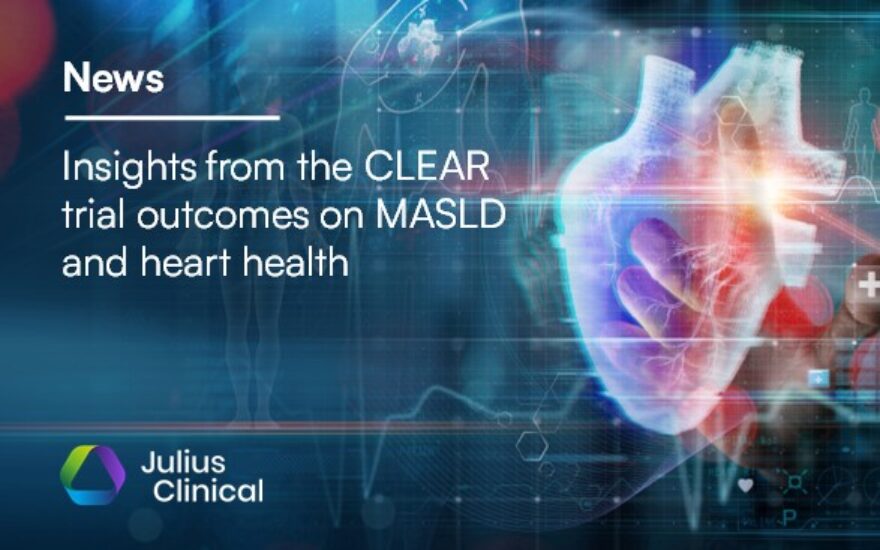Metabolic dysfunction associated steatotic liver disease and the heart
Commentary by Dr. Marco Alings, MD PhD, Amphia Ziekenhuis, Breda; WCN, Utrecht; Scientific Officer at Julius Clinical
The estimated prevalence of Metabolic Dysfunction Associated Steatotic Liver Disease (MASLD) in the adult population is 31% and rising. In a extensive review, Driessen et al describe the link between MASLD and atherosclerotic cardiovascular disease (ASCVD), the desirability of therapy addressing both conditions, and the need for multidisciplinary management.
MASLD and ASCVD share common pathophysiological risk factors (obesity, insulin resistance and type 2 diabetes mellitus, hypertension) that increase concomitantly with increasing MASLD fibrosis stages. An effect of MASLD on ASCVD seems plausible given the fact that, (1) variation in certain genes that predispose to the development of MASLD also influence VLDL secretion and plasma lipids, and (2) MASLD increases the liver release of procoagulant and pro-inflammatory factors. Nevertheless, while MASLD is associated with increased cIMT and coronary calcification, evidence of an association between MASLD in general and cardiovascular mortality risk is still lacking. More advanced stages of MASLD, however, are associated with both fatal and non-fatal cardiovascular events. Thus, stratifying for the different disease stages of MASLD may further clarify the interrelations between MASLD and ASCVD. This underscores the need for a comprehensive cardiometabolic multidisciplinary risk management in these patients.
Lifestyle modification is the cornerstone in preventing both MASLD and CVD. In addition, development of new pharmacological drugs or repurposing of existing drugs targeting both MASLD and CVD would be highly valuable. Reducing hepatic steatosis will also affect various factors linked to heart disease. Understanding whether these changes happen because of fixing the fatty liver itself (as a direct cause) or alongside the improvement of the fatty liver (as a side effect) is crucial to understand a possible causal relation between MASLD and ASCVD. Statins, ACE-inhibitors/ARBs, SGLT2is, GLP-1 RAs, PPARS and TRH- β agonists are candidates for reducing hepatic steatosis and are likely to have pleiotropic cardiometabolic effects as well. The concomitant CVD effects of these drugs in patients with MASLD should be subject of ongoing clinical trials.
The increasing prevalence of MASLD and cardiometabolic comorbidities necessitates a multidisciplinary management. Healthcare professionals in cardiometabolic prevention need to be aware of MASLD, and hepatologists need to be mindful of an increased cardiovascular risk in metabolic liver patients. The AwareNASH research project aims to raise this awareness by educating clinicians managing patients with MAFLD.
Original article:
Driessen, S., Francque, S. M., Anker, S. D., Cabezas, M. C., Grobbee, D. E., Tushuizen, M. E., & Holleboom, A. G. (2023). Metabolic dysfunction associated steatotic liver disease and the heart. Hepatology, 10-1097.
Related news
Cardiovascular risk in elderly with obesity and liver fibrosis: Benefits of statins
Commentary by Dr. Marco Alings, MD PhD, Amphia Ziekenhuis, Breda; WCN, Utrecht; Scientific Officer at Julius ClinicalThere is a strong association between age, obesity, liver fibrosis and cardiovascular (CV) disease, particularly in the conte...
Insights from the CLEAR trial outcomes on MASLD and heart health
At Julius Clinical, we are collaborating with Esperion to dive deeper into the findings of the CLEAR trial outcomes. Our focus? Investigating the relationship between metabolic dysfunction-associated steatotic liver disease (MASLD) and cardiovascu...
GRIPonMASH received significant EU funding to improve prevention and care of Metabolic dysfunction-Associated SteatoHepatitis (MASH)
Utrecht, The Netherlands, 05-02-2024GRIPonMASH, a newly founded consortium consisting of 27 European institutions and companies, has bundled resources to bring about a transformational change in the detection and treatment of Metabolic Dysfunc...



